Climate Change and Political Instability
VerifiedAdded on 2022/12/27
|8
|1891
|80
AI Summary
This paper elaborates on the role of climate change in creating political instability in the Horn of Africa region. It discusses the impact of global warming on the physical landscape and geopolitical changes that threaten to destabilize vulnerable regions. The paper also highlights the challenges faced by the Horn of Africa, including structural weaknesses and exposure to climate change risks.
Contribute Materials
Your contribution can guide someone’s learning journey. Share your
documents today.
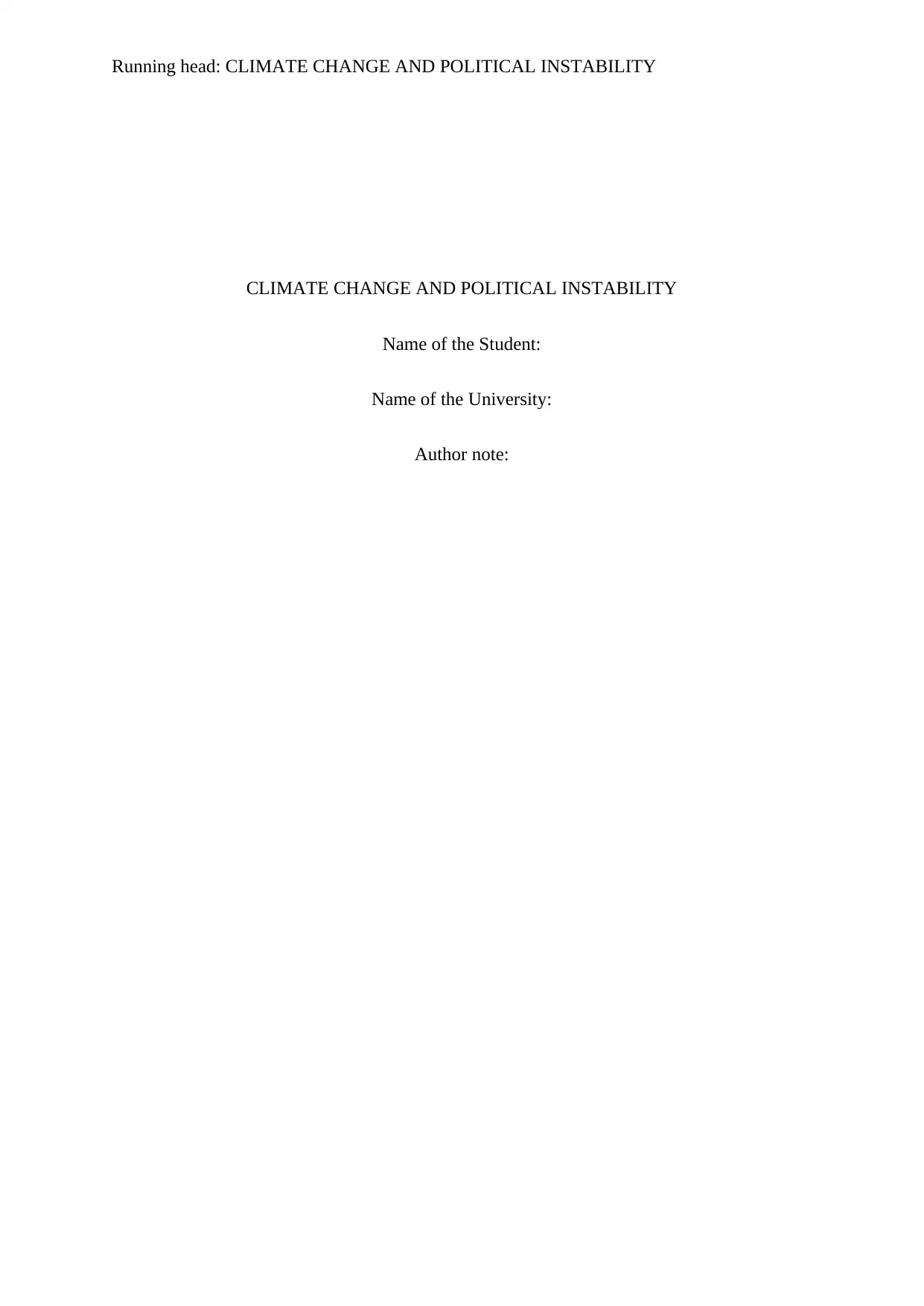
Running head: CLIMATE CHANGE AND POLITICAL INSTABILITY
CLIMATE CHANGE AND POLITICAL INSTABILITY
Name of the Student:
Name of the University:
Author note:
CLIMATE CHANGE AND POLITICAL INSTABILITY
Name of the Student:
Name of the University:
Author note:
Secure Best Marks with AI Grader
Need help grading? Try our AI Grader for instant feedback on your assignments.
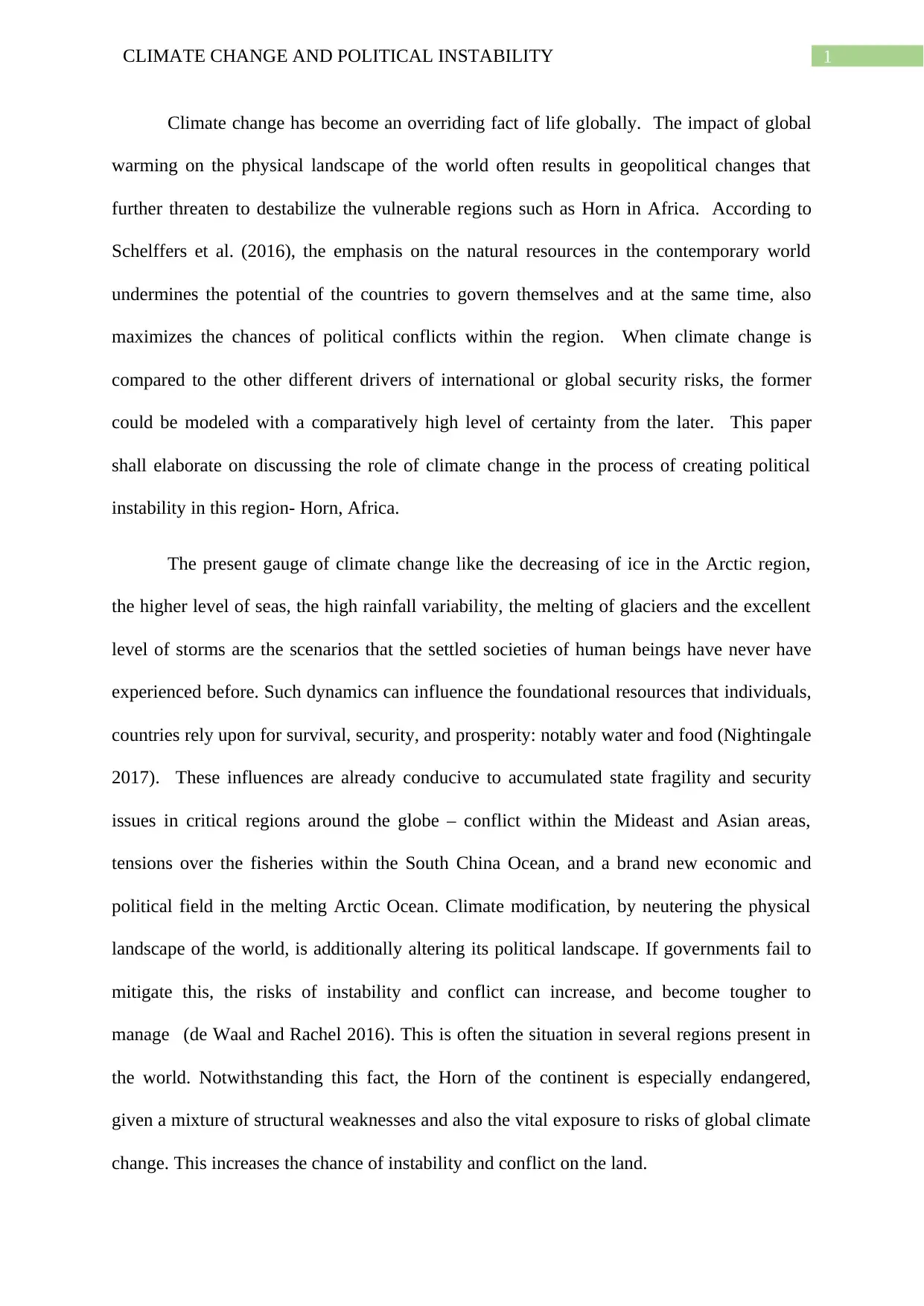
1CLIMATE CHANGE AND POLITICAL INSTABILITY
Climate change has become an overriding fact of life globally. “The impact of global
warming on the physical landscape of the world often results in geopolitical changes that
further threaten to destabilize the vulnerable regions such as Horn in Africa.” According to
Schelffers et al. (2016), the emphasis on the natural resources in the contemporary world
undermines the potential of the countries to govern themselves and at the same time, also
maximizes the chances of political conflicts within the region. “When climate change is
compared to the other different drivers of international or global security risks, the former
could be modeled with a comparatively high level of certainty from the later.” This paper
shall elaborate on discussing the role of climate change in the process of creating political
instability in this region- Horn, Africa.
The present gauge of climate change like the decreasing of ice in the Arctic region,
the higher level of seas, the high rainfall variability, the melting of glaciers and the excellent
level of storms are the scenarios that the settled societies of human beings have never have
experienced before. Such dynamics can influence the foundational resources that individuals,
countries rely upon for survival, security, and prosperity: notably water and food (Nightingale
2017). “These influences are already conducive to accumulated state fragility and security
issues in critical regions around the globe – conflict within the Mideast and Asian areas,
tensions over the fisheries within the South China Ocean, and a brand new economic and
political field in the melting Arctic Ocean. Climate modification, by neutering the physical
landscape of the world, is additionally altering its political landscape. If governments fail to
mitigate this, the risks of instability and conflict can increase, and become tougher to
manage” (de Waal and Rachel 2016). This is often the situation in several regions present in
the world. Notwithstanding this fact, the Horn of the continent is especially endangered,
given a mixture of structural weaknesses and also the vital exposure to risks of global climate
change. This increases the chance of instability and conflict on the land.
Climate change has become an overriding fact of life globally. “The impact of global
warming on the physical landscape of the world often results in geopolitical changes that
further threaten to destabilize the vulnerable regions such as Horn in Africa.” According to
Schelffers et al. (2016), the emphasis on the natural resources in the contemporary world
undermines the potential of the countries to govern themselves and at the same time, also
maximizes the chances of political conflicts within the region. “When climate change is
compared to the other different drivers of international or global security risks, the former
could be modeled with a comparatively high level of certainty from the later.” This paper
shall elaborate on discussing the role of climate change in the process of creating political
instability in this region- Horn, Africa.
The present gauge of climate change like the decreasing of ice in the Arctic region,
the higher level of seas, the high rainfall variability, the melting of glaciers and the excellent
level of storms are the scenarios that the settled societies of human beings have never have
experienced before. Such dynamics can influence the foundational resources that individuals,
countries rely upon for survival, security, and prosperity: notably water and food (Nightingale
2017). “These influences are already conducive to accumulated state fragility and security
issues in critical regions around the globe – conflict within the Mideast and Asian areas,
tensions over the fisheries within the South China Ocean, and a brand new economic and
political field in the melting Arctic Ocean. Climate modification, by neutering the physical
landscape of the world, is additionally altering its political landscape. If governments fail to
mitigate this, the risks of instability and conflict can increase, and become tougher to
manage” (de Waal and Rachel 2016). This is often the situation in several regions present in
the world. Notwithstanding this fact, the Horn of the continent is especially endangered,
given a mixture of structural weaknesses and also the vital exposure to risks of global climate
change. This increases the chance of instability and conflict on the land.
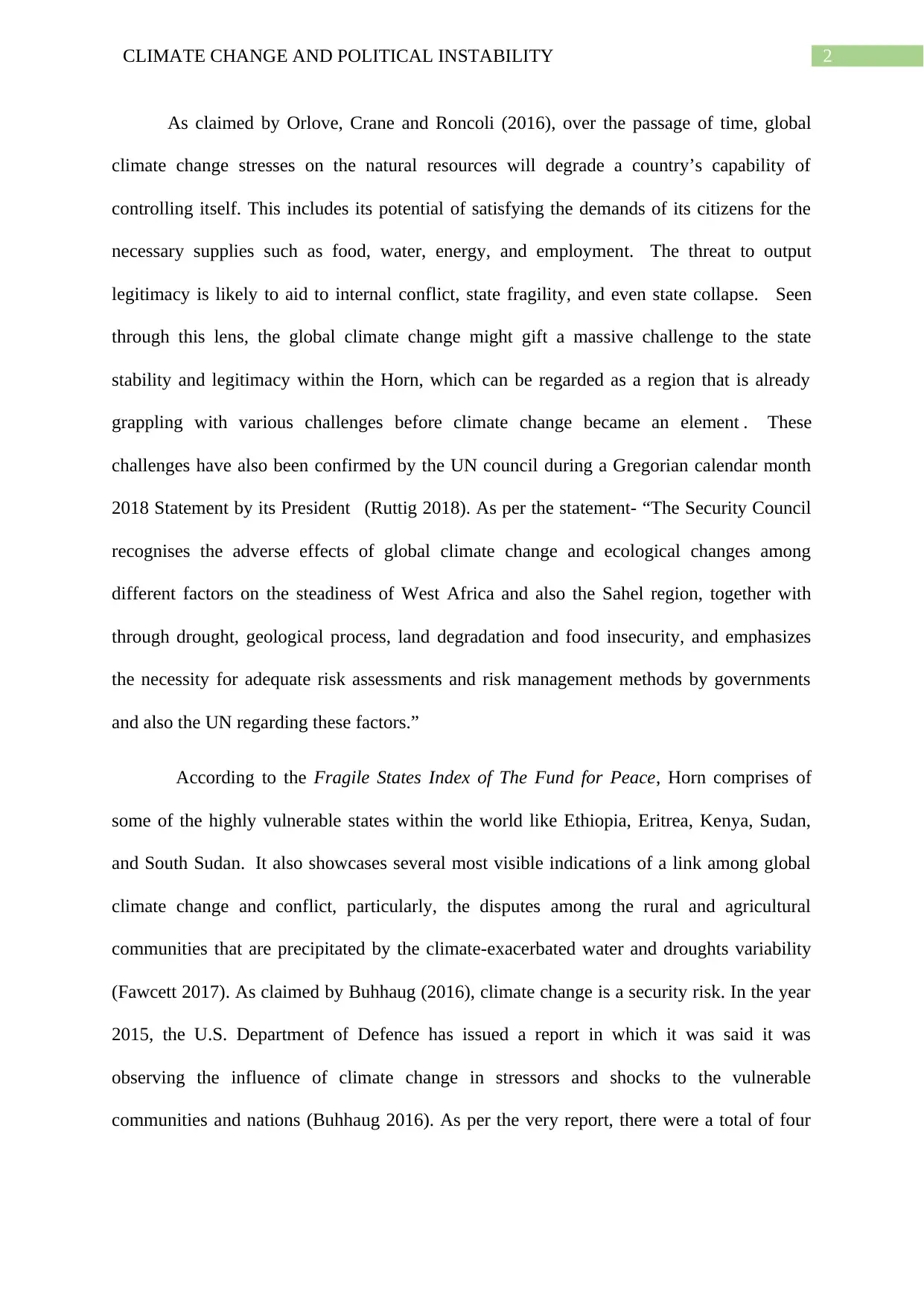
2CLIMATE CHANGE AND POLITICAL INSTABILITY
As claimed by Orlove, Crane and Roncoli (2016), over the passage of time, global
climate change stresses on the natural resources will degrade a country’s capability of
controlling itself. This includes its potential of satisfying the demands of its citizens for the
necessary supplies such as food, water, energy, and employment. “The threat to output
legitimacy is likely to aid to internal conflict, state fragility, and even state collapse. ”“Seen
through this lens, the global climate change might gift a massive challenge to the state
stability and legitimacy within the Horn, which can be regarded as a region that is already
grappling with various challenges before climate change became an element”. “These
challenges have also been confirmed by the UN council during a Gregorian calendar month
2018 Statement by its President” (Ruttig 2018). As per the statement- “The Security Council
recognises the adverse effects of global climate change and ecological changes among
different factors on the steadiness of West Africa and also the Sahel region, together with
through drought, geological process, land degradation and food insecurity, and emphasizes
the necessity for adequate risk assessments and risk management methods by governments
and also the UN regarding these factors.”
“According to the Fragile States Index of The Fund for Peace, Horn comprises of
some of the highly vulnerable states within the world like Ethiopia, Eritrea, Kenya, Sudan,
and South Sudan.” It also showcases several most visible indications of a link among global
climate change and conflict, particularly, the disputes among the rural and agricultural
communities that are precipitated by the climate-exacerbated water and droughts variability
(Fawcett 2017). As claimed by Buhhaug (2016), climate change is a security risk. In the year
2015, the U.S. Department of Defence has issued a report in which it was said it was
observing the influence of climate change in stressors and shocks to the vulnerable
communities and nations (Buhhaug 2016). As per the very report, there were a total of four
As claimed by Orlove, Crane and Roncoli (2016), over the passage of time, global
climate change stresses on the natural resources will degrade a country’s capability of
controlling itself. This includes its potential of satisfying the demands of its citizens for the
necessary supplies such as food, water, energy, and employment. “The threat to output
legitimacy is likely to aid to internal conflict, state fragility, and even state collapse. ”“Seen
through this lens, the global climate change might gift a massive challenge to the state
stability and legitimacy within the Horn, which can be regarded as a region that is already
grappling with various challenges before climate change became an element”. “These
challenges have also been confirmed by the UN council during a Gregorian calendar month
2018 Statement by its President” (Ruttig 2018). As per the statement- “The Security Council
recognises the adverse effects of global climate change and ecological changes among
different factors on the steadiness of West Africa and also the Sahel region, together with
through drought, geological process, land degradation and food insecurity, and emphasizes
the necessity for adequate risk assessments and risk management methods by governments
and also the UN regarding these factors.”
“According to the Fragile States Index of The Fund for Peace, Horn comprises of
some of the highly vulnerable states within the world like Ethiopia, Eritrea, Kenya, Sudan,
and South Sudan.” It also showcases several most visible indications of a link among global
climate change and conflict, particularly, the disputes among the rural and agricultural
communities that are precipitated by the climate-exacerbated water and droughts variability
(Fawcett 2017). As claimed by Buhhaug (2016), climate change is a security risk. In the year
2015, the U.S. Department of Defence has issued a report in which it was said it was
observing the influence of climate change in stressors and shocks to the vulnerable
communities and nations (Buhhaug 2016). As per the very report, there were a total of four
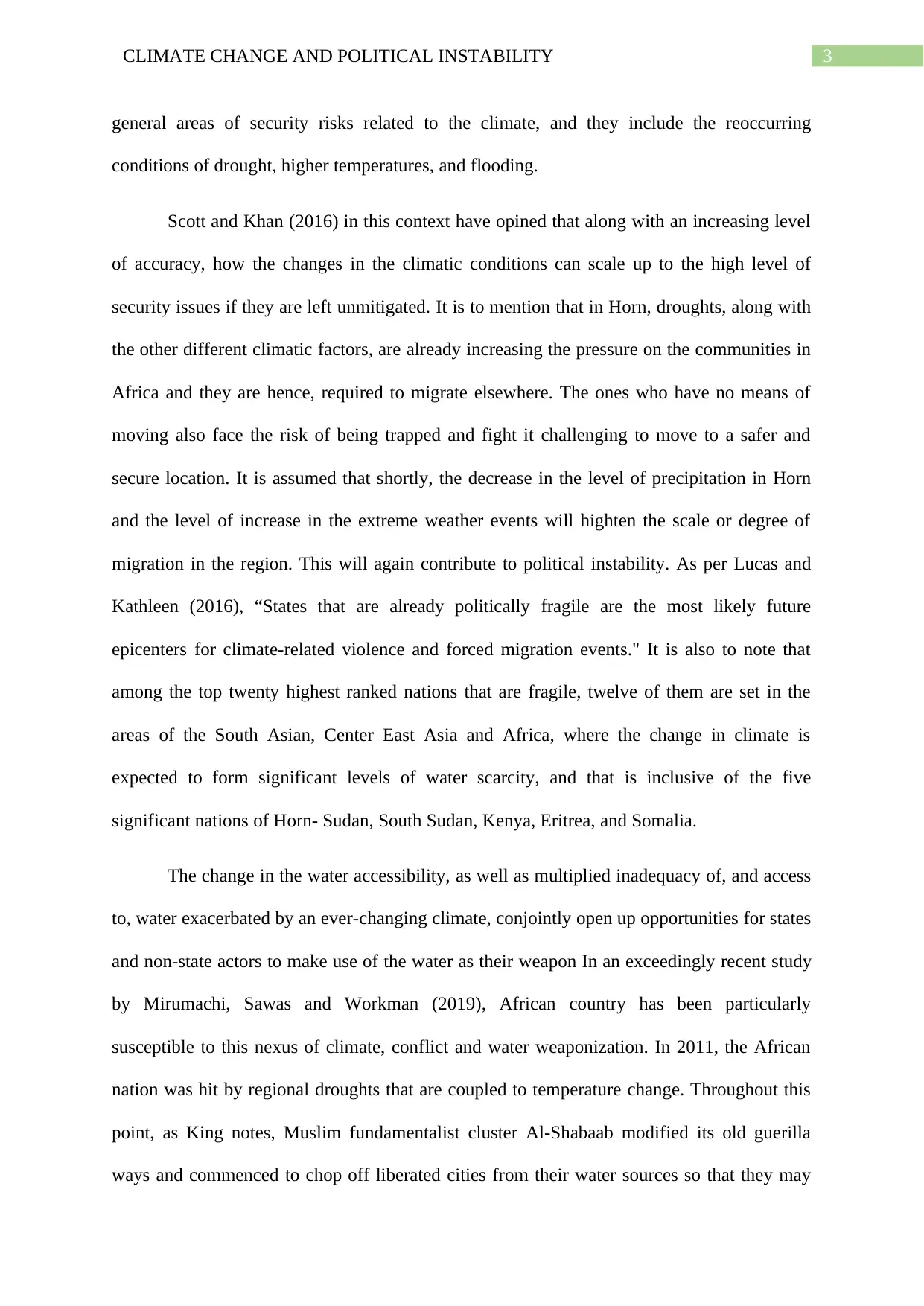
3CLIMATE CHANGE AND POLITICAL INSTABILITY
general areas of security risks related to the climate, and they include the reoccurring
conditions of drought, higher temperatures, and flooding.
Scott and Khan (2016) in this context have opined that along with an increasing level
of accuracy, how the changes in the climatic conditions can scale up to the high level of
security issues if they are left unmitigated. It is to mention that in Horn, droughts, along with
the other different climatic factors, are already increasing the pressure on the communities in
Africa and they are hence, required to migrate elsewhere. The ones who have no means of
moving also face the risk of being trapped and fight it challenging to move to a safer and
secure location. It is assumed that shortly, the decrease in the level of precipitation in Horn
and the level of increase in the extreme weather events will highten the scale or degree of
migration in the region. This will again contribute to political instability. As per Lucas and
Kathleen (2016), “States that are already politically fragile are the most likely future
epicenters for climate-related violence and forced migration events." It is also to note that
among the top twenty highest ranked nations that are fragile, twelve of them are set in the
areas of the South Asian, Center East Asia and Africa, where the change in climate is
expected to form significant levels of water scarcity, and that is inclusive of the five
significant nations of Horn- Sudan, South Sudan, Kenya, Eritrea, and Somalia.
The change in the water accessibility, as well as multiplied inadequacy of, and access
to, water exacerbated by an ever-changing climate, conjointly open up opportunities for states
and non-state actors to make use of the water as their weapon In an exceedingly recent study
by Mirumachi, Sawas and Workman (2019), African country has been particularly
susceptible to this nexus of climate, conflict and water weaponization. In 2011, the African
nation was hit by regional droughts that are coupled to temperature change. Throughout this
point, as King notes, Muslim fundamentalist cluster Al-Shabaab modified its old guerilla
ways and commenced to chop off liberated cities from their water sources so that they may
general areas of security risks related to the climate, and they include the reoccurring
conditions of drought, higher temperatures, and flooding.
Scott and Khan (2016) in this context have opined that along with an increasing level
of accuracy, how the changes in the climatic conditions can scale up to the high level of
security issues if they are left unmitigated. It is to mention that in Horn, droughts, along with
the other different climatic factors, are already increasing the pressure on the communities in
Africa and they are hence, required to migrate elsewhere. The ones who have no means of
moving also face the risk of being trapped and fight it challenging to move to a safer and
secure location. It is assumed that shortly, the decrease in the level of precipitation in Horn
and the level of increase in the extreme weather events will highten the scale or degree of
migration in the region. This will again contribute to political instability. As per Lucas and
Kathleen (2016), “States that are already politically fragile are the most likely future
epicenters for climate-related violence and forced migration events." It is also to note that
among the top twenty highest ranked nations that are fragile, twelve of them are set in the
areas of the South Asian, Center East Asia and Africa, where the change in climate is
expected to form significant levels of water scarcity, and that is inclusive of the five
significant nations of Horn- Sudan, South Sudan, Kenya, Eritrea, and Somalia.
The change in the water accessibility, as well as multiplied inadequacy of, and access
to, water exacerbated by an ever-changing climate, conjointly open up opportunities for states
and non-state actors to make use of the water as their weapon In an exceedingly recent study
by Mirumachi, Sawas and Workman (2019), African country has been particularly
susceptible to this nexus of climate, conflict and water weaponization. In 2011, the African
nation was hit by regional droughts that are coupled to temperature change. Throughout this
point, as King notes, Muslim fundamentalist cluster Al-Shabaab modified its old guerilla
ways and commenced to chop off liberated cities from their water sources so that they may
Secure Best Marks with AI Grader
Need help grading? Try our AI Grader for instant feedback on your assignments.
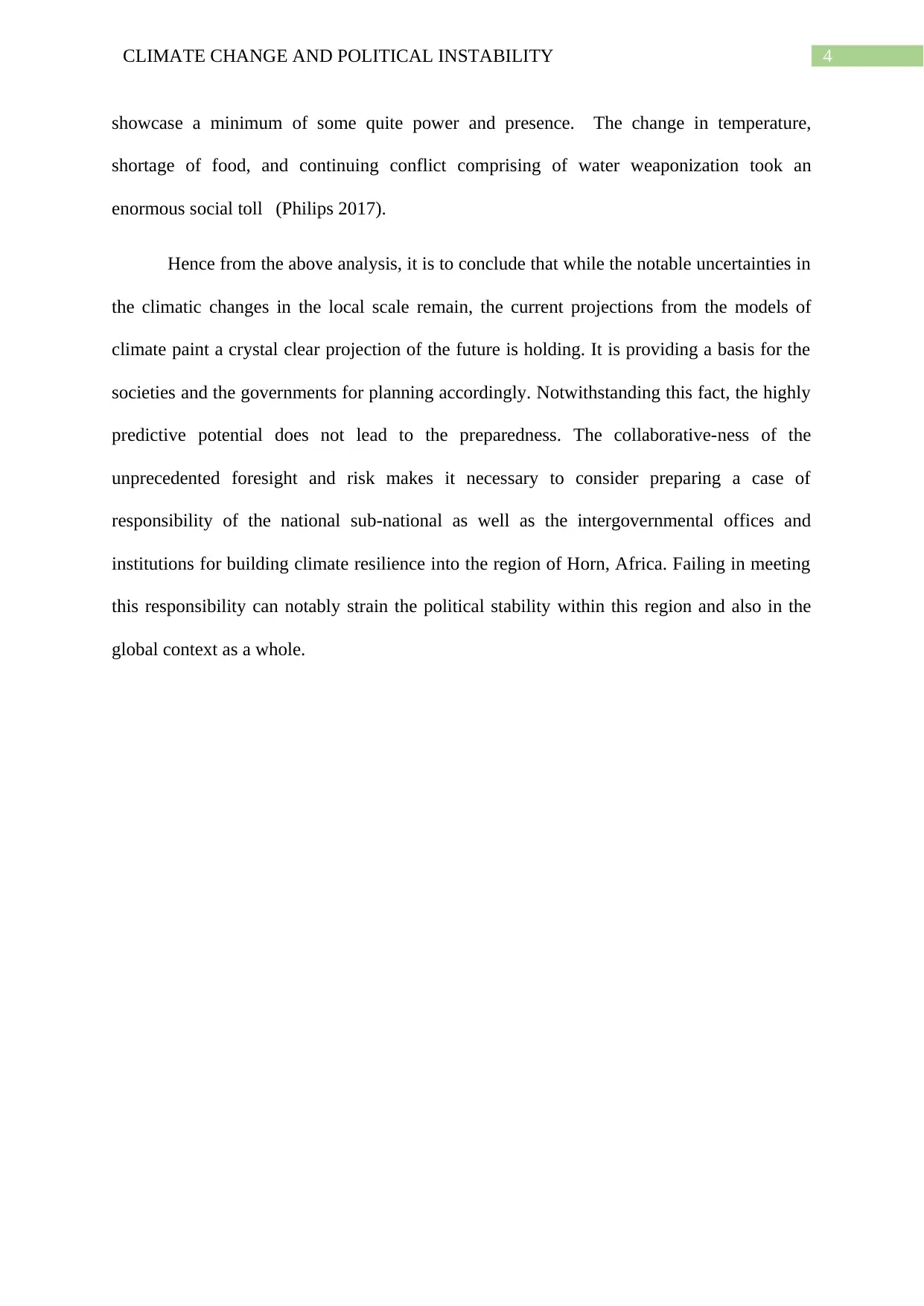
4CLIMATE CHANGE AND POLITICAL INSTABILITY
showcase a minimum of some quite power and presence. “The change in temperature,
shortage of food, and continuing conflict comprising of water weaponization took an
enormous social toll” (Philips 2017).
Hence from the above analysis, it is to conclude that while the notable uncertainties in
the climatic changes in the local scale remain, the current projections from the models of
climate paint a crystal clear projection of the future is holding. It is providing a basis for the
societies and the governments for planning accordingly. Notwithstanding this fact, the highly
predictive potential does not lead to the preparedness. The collaborative-ness of the
unprecedented foresight and risk makes it necessary to consider preparing a case of
responsibility of the national sub-national as well as the intergovernmental offices and
institutions for building climate resilience into the region of Horn, Africa. Failing in meeting
this responsibility can notably strain the political stability within this region and also in the
global context as a whole.
showcase a minimum of some quite power and presence. “The change in temperature,
shortage of food, and continuing conflict comprising of water weaponization took an
enormous social toll” (Philips 2017).
Hence from the above analysis, it is to conclude that while the notable uncertainties in
the climatic changes in the local scale remain, the current projections from the models of
climate paint a crystal clear projection of the future is holding. It is providing a basis for the
societies and the governments for planning accordingly. Notwithstanding this fact, the highly
predictive potential does not lead to the preparedness. The collaborative-ness of the
unprecedented foresight and risk makes it necessary to consider preparing a case of
responsibility of the national sub-national as well as the intergovernmental offices and
institutions for building climate resilience into the region of Horn, Africa. Failing in meeting
this responsibility can notably strain the political stability within this region and also in the
global context as a whole.
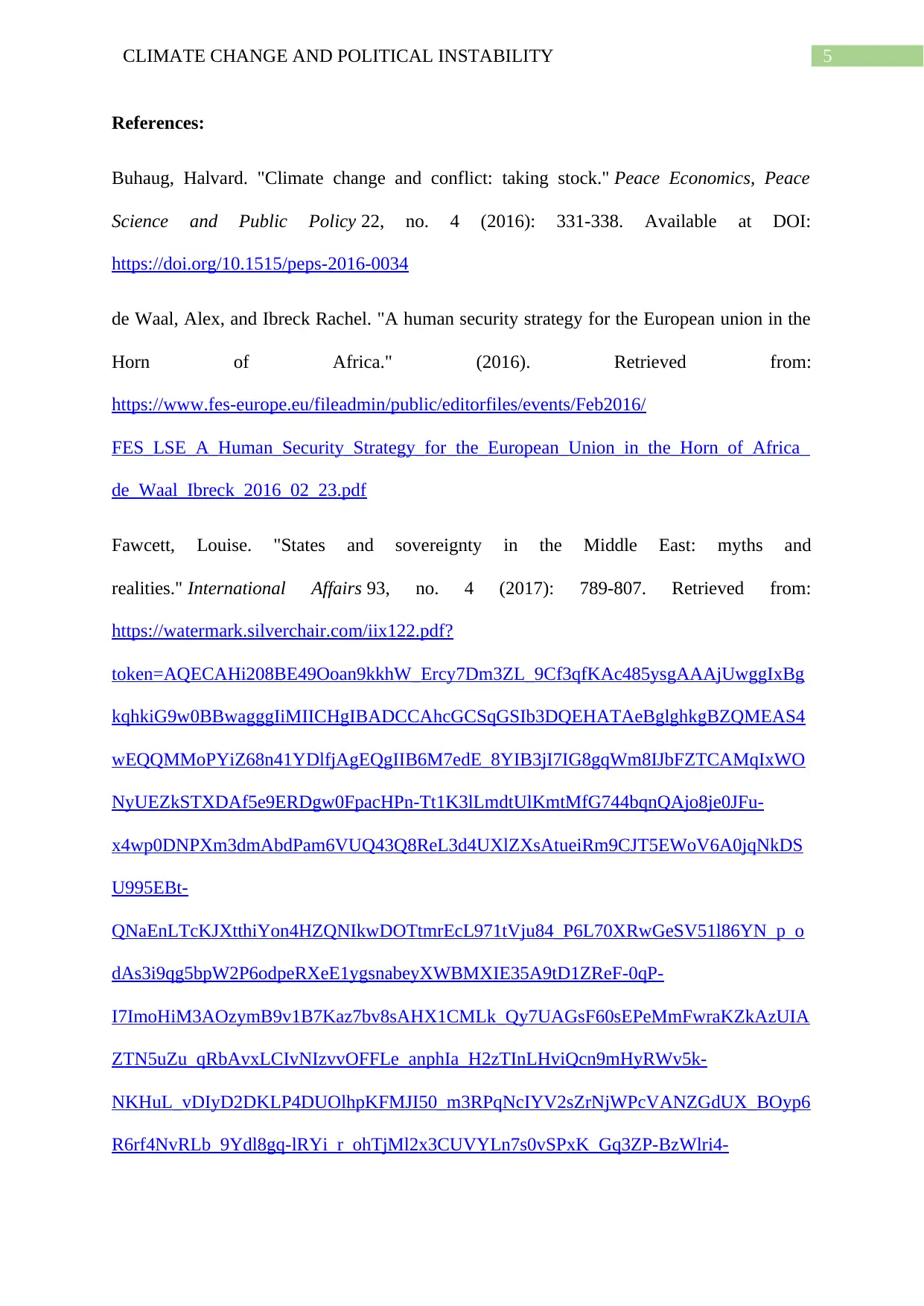
5CLIMATE CHANGE AND POLITICAL INSTABILITY
References:
Buhaug, Halvard. "Climate change and conflict: taking stock." Peace Economics, Peace
Science and Public Policy 22, no. 4 (2016): 331-338. Available at DOI:
https://doi.org/10.1515/peps-2016-0034
de Waal, Alex, and Ibreck Rachel. "A human security strategy for the European union in the
Horn of Africa." (2016). Retrieved from:
https://www.fes-europe.eu/fileadmin/public/editorfiles/events/Feb2016/
FES_LSE_A_Human_Security_Strategy_for_the_European_Union_in_the_Horn_of_Africa_
de_Waal_Ibreck_2016_02_23.pdf
Fawcett, Louise. "States and sovereignty in the Middle East: myths and
realities." International Affairs 93, no. 4 (2017): 789-807. Retrieved from:
https://watermark.silverchair.com/iix122.pdf?
token=AQECAHi208BE49Ooan9kkhW_Ercy7Dm3ZL_9Cf3qfKAc485ysgAAAjUwggIxBg
kqhkiG9w0BBwagggIiMIICHgIBADCCAhcGCSqGSIb3DQEHATAeBglghkgBZQMEAS4
wEQQMMoPYiZ68n41YDlfjAgEQgIIB6M7edE_8YIB3jI7IG8gqWm8IJbFZTCAMqIxWO
NyUEZkSTXDAf5e9ERDgw0FpacHPn-Tt1K3lLmdtUlKmtMfG744bqnQAjo8je0JFu-
x4wp0DNPXm3dmAbdPam6VUQ43Q8ReL3d4UXlZXsAtueiRm9CJT5EWoV6A0jqNkDS
U995EBt-
QNaEnLTcKJXtthiYon4HZQNIkwDOTtmrEcL971tVju84_P6L70XRwGeSV51l86YN_p_o
dAs3i9qg5bpW2P6odpeRXeE1ygsnabeyXWBMXIE35A9tD1ZReF-0qP-
I7ImoHiM3AOzymB9v1B7Kaz7bv8sAHX1CMLk_Qy7UAGsF60sEPeMmFwraKZkAzUIA
ZTN5uZu_qRbAvxLCIvNIzvvOFFLe_anphIa_H2zTInLHviQcn9mHyRWv5k-
NKHuL_vDIyD2DKLP4DUOlhpKFMJI50_m3RPqNcIYV2sZrNjWPcVANZGdUX_BOyp6
R6rf4NvRLb_9Ydl8gq-lRYi_r_ohTjMl2x3CUVYLn7s0vSPxK_Gq3ZP-BzWlri4-
References:
Buhaug, Halvard. "Climate change and conflict: taking stock." Peace Economics, Peace
Science and Public Policy 22, no. 4 (2016): 331-338. Available at DOI:
https://doi.org/10.1515/peps-2016-0034
de Waal, Alex, and Ibreck Rachel. "A human security strategy for the European union in the
Horn of Africa." (2016). Retrieved from:
https://www.fes-europe.eu/fileadmin/public/editorfiles/events/Feb2016/
FES_LSE_A_Human_Security_Strategy_for_the_European_Union_in_the_Horn_of_Africa_
de_Waal_Ibreck_2016_02_23.pdf
Fawcett, Louise. "States and sovereignty in the Middle East: myths and
realities." International Affairs 93, no. 4 (2017): 789-807. Retrieved from:
https://watermark.silverchair.com/iix122.pdf?
token=AQECAHi208BE49Ooan9kkhW_Ercy7Dm3ZL_9Cf3qfKAc485ysgAAAjUwggIxBg
kqhkiG9w0BBwagggIiMIICHgIBADCCAhcGCSqGSIb3DQEHATAeBglghkgBZQMEAS4
wEQQMMoPYiZ68n41YDlfjAgEQgIIB6M7edE_8YIB3jI7IG8gqWm8IJbFZTCAMqIxWO
NyUEZkSTXDAf5e9ERDgw0FpacHPn-Tt1K3lLmdtUlKmtMfG744bqnQAjo8je0JFu-
x4wp0DNPXm3dmAbdPam6VUQ43Q8ReL3d4UXlZXsAtueiRm9CJT5EWoV6A0jqNkDS
U995EBt-
QNaEnLTcKJXtthiYon4HZQNIkwDOTtmrEcL971tVju84_P6L70XRwGeSV51l86YN_p_o
dAs3i9qg5bpW2P6odpeRXeE1ygsnabeyXWBMXIE35A9tD1ZReF-0qP-
I7ImoHiM3AOzymB9v1B7Kaz7bv8sAHX1CMLk_Qy7UAGsF60sEPeMmFwraKZkAzUIA
ZTN5uZu_qRbAvxLCIvNIzvvOFFLe_anphIa_H2zTInLHviQcn9mHyRWv5k-
NKHuL_vDIyD2DKLP4DUOlhpKFMJI50_m3RPqNcIYV2sZrNjWPcVANZGdUX_BOyp6
R6rf4NvRLb_9Ydl8gq-lRYi_r_ohTjMl2x3CUVYLn7s0vSPxK_Gq3ZP-BzWlri4-
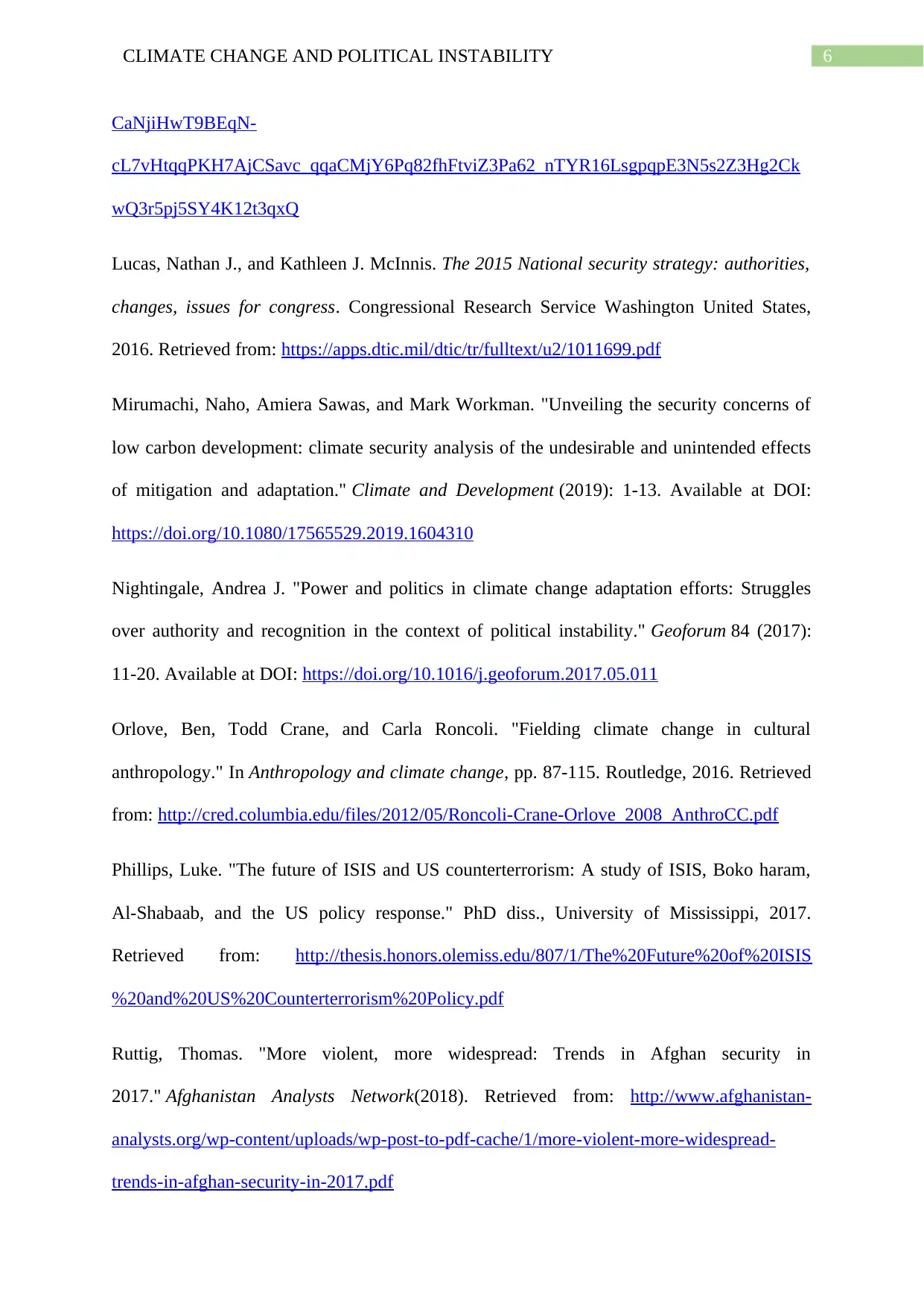
6CLIMATE CHANGE AND POLITICAL INSTABILITY
CaNjiHwT9BEqN-
cL7vHtqqPKH7AjCSavc_qqaCMjY6Pq82fhFtviZ3Pa62_nTYR16LsgpqpE3N5s2Z3Hg2Ck
wQ3r5pj5SY4K12t3qxQ
Lucas, Nathan J., and Kathleen J. McInnis. The 2015 National security strategy: authorities,
changes, issues for congress. Congressional Research Service Washington United States,
2016. Retrieved from: https://apps.dtic.mil/dtic/tr/fulltext/u2/1011699.pdf
Mirumachi, Naho, Amiera Sawas, and Mark Workman. "Unveiling the security concerns of
low carbon development: climate security analysis of the undesirable and unintended effects
of mitigation and adaptation." Climate and Development (2019): 1-13. Available at DOI:
https://doi.org/10.1080/17565529.2019.1604310
Nightingale, Andrea J. "Power and politics in climate change adaptation efforts: Struggles
over authority and recognition in the context of political instability." Geoforum 84 (2017):
11-20. Available at DOI: https://doi.org/10.1016/j.geoforum.2017.05.011
Orlove, Ben, Todd Crane, and Carla Roncoli. "Fielding climate change in cultural
anthropology." In Anthropology and climate change, pp. 87-115. Routledge, 2016. Retrieved
from: http://cred.columbia.edu/files/2012/05/Roncoli-Crane-Orlove_2008_AnthroCC.pdf
Phillips, Luke. "The future of ISIS and US counterterrorism: A study of ISIS, Boko haram,
Al-Shabaab, and the US policy response." PhD diss., University of Mississippi, 2017.
Retrieved from: http://thesis.honors.olemiss.edu/807/1/The%20Future%20of%20ISIS
%20and%20US%20Counterterrorism%20Policy.pdf
Ruttig, Thomas. "More violent, more widespread: Trends in Afghan security in
2017." Afghanistan Analysts Network(2018). Retrieved from: http://www.afghanistan-
analysts.org/wp-content/uploads/wp-post-to-pdf-cache/1/more-violent-more-widespread-
trends-in-afghan-security-in-2017.pdf
CaNjiHwT9BEqN-
cL7vHtqqPKH7AjCSavc_qqaCMjY6Pq82fhFtviZ3Pa62_nTYR16LsgpqpE3N5s2Z3Hg2Ck
wQ3r5pj5SY4K12t3qxQ
Lucas, Nathan J., and Kathleen J. McInnis. The 2015 National security strategy: authorities,
changes, issues for congress. Congressional Research Service Washington United States,
2016. Retrieved from: https://apps.dtic.mil/dtic/tr/fulltext/u2/1011699.pdf
Mirumachi, Naho, Amiera Sawas, and Mark Workman. "Unveiling the security concerns of
low carbon development: climate security analysis of the undesirable and unintended effects
of mitigation and adaptation." Climate and Development (2019): 1-13. Available at DOI:
https://doi.org/10.1080/17565529.2019.1604310
Nightingale, Andrea J. "Power and politics in climate change adaptation efforts: Struggles
over authority and recognition in the context of political instability." Geoforum 84 (2017):
11-20. Available at DOI: https://doi.org/10.1016/j.geoforum.2017.05.011
Orlove, Ben, Todd Crane, and Carla Roncoli. "Fielding climate change in cultural
anthropology." In Anthropology and climate change, pp. 87-115. Routledge, 2016. Retrieved
from: http://cred.columbia.edu/files/2012/05/Roncoli-Crane-Orlove_2008_AnthroCC.pdf
Phillips, Luke. "The future of ISIS and US counterterrorism: A study of ISIS, Boko haram,
Al-Shabaab, and the US policy response." PhD diss., University of Mississippi, 2017.
Retrieved from: http://thesis.honors.olemiss.edu/807/1/The%20Future%20of%20ISIS
%20and%20US%20Counterterrorism%20Policy.pdf
Ruttig, Thomas. "More violent, more widespread: Trends in Afghan security in
2017." Afghanistan Analysts Network(2018). Retrieved from: http://www.afghanistan-
analysts.org/wp-content/uploads/wp-post-to-pdf-cache/1/more-violent-more-widespread-
trends-in-afghan-security-in-2017.pdf
Paraphrase This Document
Need a fresh take? Get an instant paraphrase of this document with our AI Paraphraser
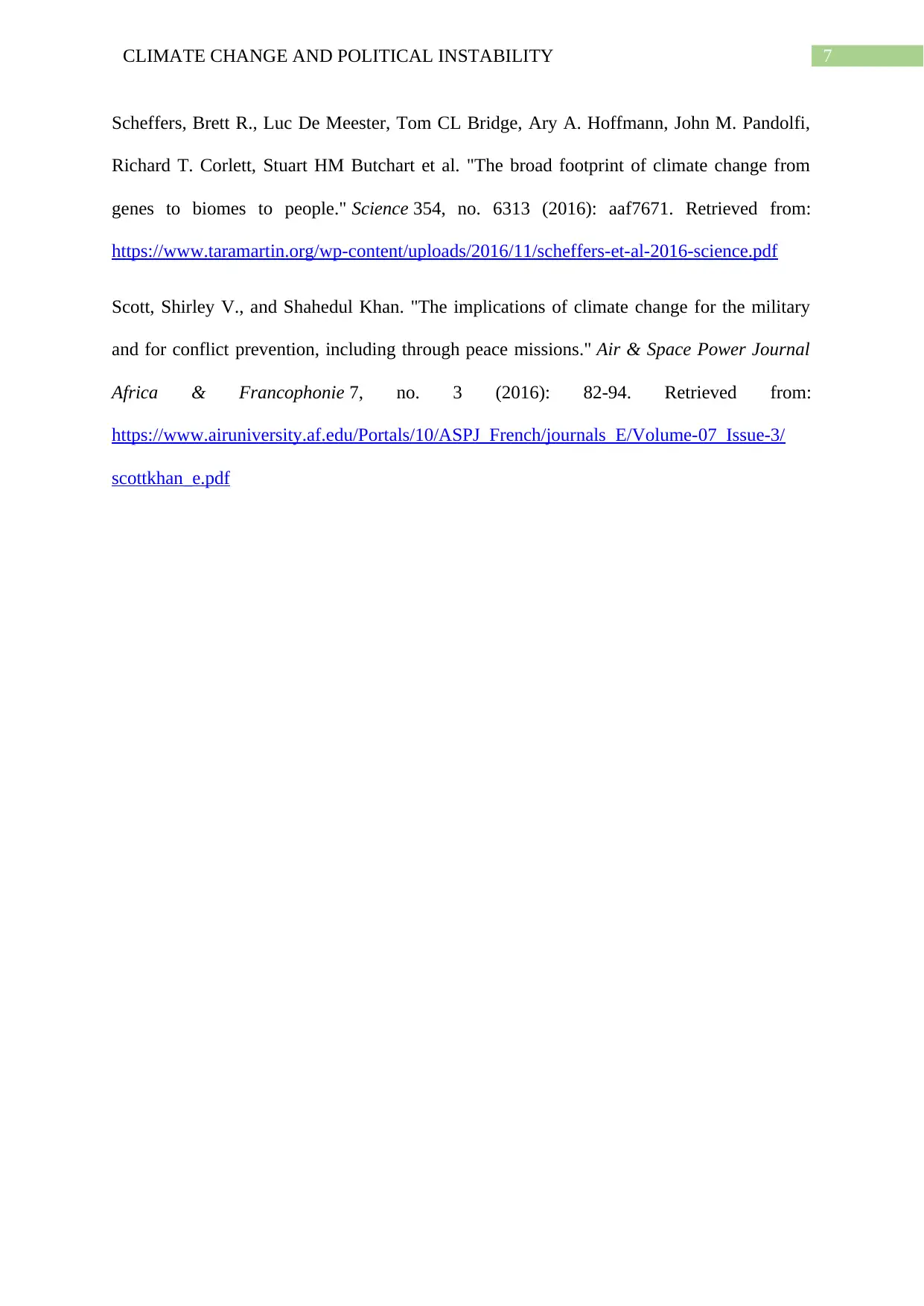
7CLIMATE CHANGE AND POLITICAL INSTABILITY
Scheffers, Brett R., Luc De Meester, Tom CL Bridge, Ary A. Hoffmann, John M. Pandolfi,
Richard T. Corlett, Stuart HM Butchart et al. "The broad footprint of climate change from
genes to biomes to people." Science 354, no. 6313 (2016): aaf7671. Retrieved from:
https://www.taramartin.org/wp-content/uploads/2016/11/scheffers-et-al-2016-science.pdf
Scott, Shirley V., and Shahedul Khan. "The implications of climate change for the military
and for conflict prevention, including through peace missions." Air & Space Power Journal
Africa & Francophonie 7, no. 3 (2016): 82-94. Retrieved from:
https://www.airuniversity.af.edu/Portals/10/ASPJ_French/journals_E/Volume-07_Issue-3/
scottkhan_e.pdf
Scheffers, Brett R., Luc De Meester, Tom CL Bridge, Ary A. Hoffmann, John M. Pandolfi,
Richard T. Corlett, Stuart HM Butchart et al. "The broad footprint of climate change from
genes to biomes to people." Science 354, no. 6313 (2016): aaf7671. Retrieved from:
https://www.taramartin.org/wp-content/uploads/2016/11/scheffers-et-al-2016-science.pdf
Scott, Shirley V., and Shahedul Khan. "The implications of climate change for the military
and for conflict prevention, including through peace missions." Air & Space Power Journal
Africa & Francophonie 7, no. 3 (2016): 82-94. Retrieved from:
https://www.airuniversity.af.edu/Portals/10/ASPJ_French/journals_E/Volume-07_Issue-3/
scottkhan_e.pdf
1 out of 8
Related Documents
Your All-in-One AI-Powered Toolkit for Academic Success.
+13062052269
info@desklib.com
Available 24*7 on WhatsApp / Email
![[object Object]](/_next/static/media/star-bottom.7253800d.svg)
Unlock your academic potential
© 2024 | Zucol Services PVT LTD | All rights reserved.





